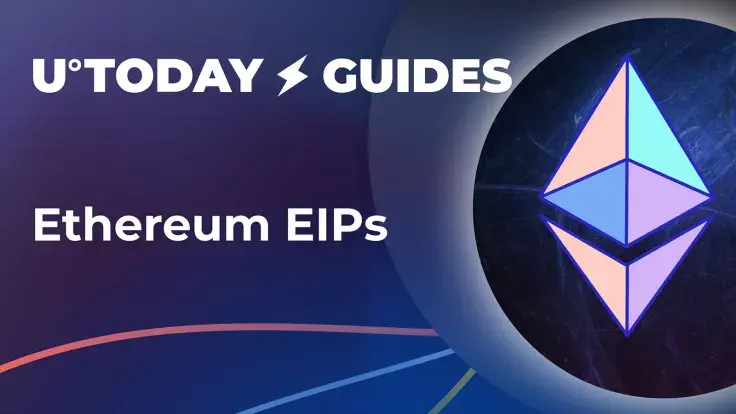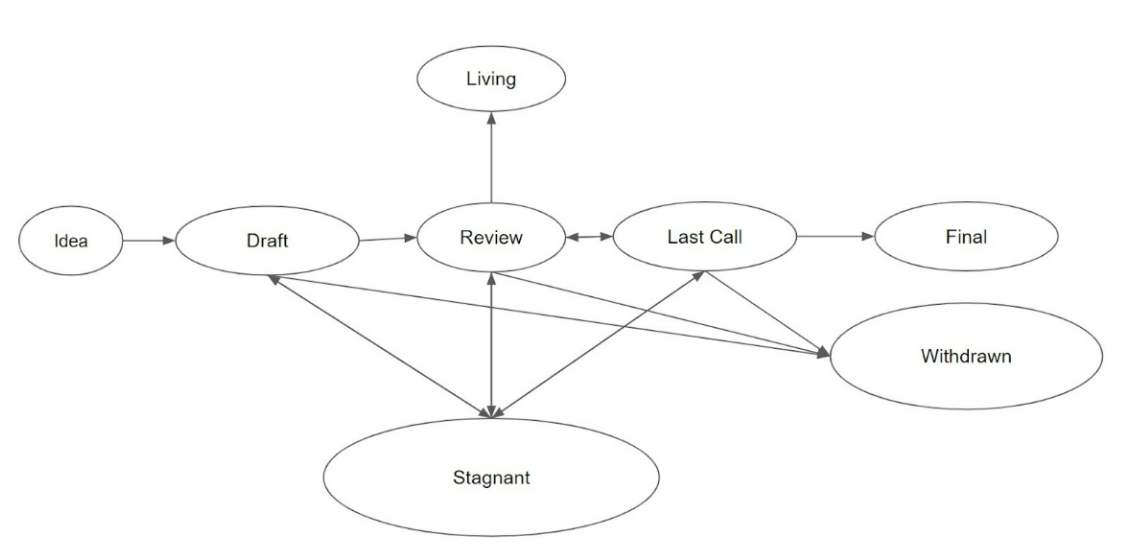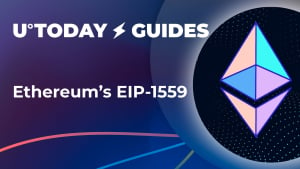
- Ethereum Improvement Proposals (EIPs): Brief Introduction
- What is Ethereum (ETH)?
- What is Ethereum Improvement Proposal (EIP)?
- What is Bitcoin Improvement Proposal (BIP)?
- How do EIPs affect Ethereum (ETH) price?
- Crucial EIPs of 2015-2021: From tokens to proof of stake
- Most anticipated EIPs for near future
- Closing thoughts
In Q4, 2022, Ethereum (ETH) remains the largest platform for decentralized applications (dApps), including decentralized finance applications (DeFis). As such, every upgrade to its codebase is set to affect the crypto journeys of millions of crypto users.
Ethereum Improvement Proposals, or EIPs, are a class of proposals designed to upgrade the technical design of Ethereum (ETH) in order to make it more attack-resistant and resource-efficient, as well as to introduce previously unseen functionalities.
In this review, we are going to cover the concept of an EIP and study some upcoming EIPs that are set to be crucial for the progress and adoption of Ethereum (ETH).
Ethereum Improvement Proposals (EIPs): Brief Introduction
To be ready for any challenge of the turbulent Web3 segment, Ethereum (ETH) needs to adjust its codebase. Here is why everyone can propose a change to its mechanism and advance the way Ethereum (ETH) handles crypto transactions:
— Ethereum Improvement Proposals, or EIPs, are suggestions published by Ethereum (ETH) enthusiasts in order to improve or enrich its technical design.
— Every developer can publish an EIP, while every Ethereum.org user can review it and provide feedback.
— While publishing an EIP, its author should unveil its rationale, motivation, technical details and its shortest non-tech review (abstract).
— All EIPs should undergo a multi-level process of discussion with top Ethereum (ETH) contributors.
— Once approved, major EIPs are integrated into Ethereum’s codebase (largely via hard forks).
— Discussions on EIPs might last several months.
Ideologically, the EIP reviewing process is a symbol of democracy, transparency, inclusiveness and decentralization of the Ethereum (ETH) community.
What is Ethereum (ETH)?
Ethereum (ETH) is the first-ever blockchain that implemented smart contracts or a “hosting platform” for decentralized applications. Ethereum (ETH) was launched on the mainnet in July 2015; Vitalik Buterin, Gavin Wood and Joseph Lubin are among its key figureheads.
Ethereum (ETH) remains the most popular blockchain for decentralized applications: its distributed computational power supercharges decentralized finance protocols (DeFis), marketplaces for non-fungible tokens (NFTs), on-chain games and so on.
What is Ethereum Improvement Proposal (EIP)?
An Ethereum Improvement Proposal, or EIP, is a public proposal made by an Ethereum (ETH) enthusiast that describes the concept of a potentially useful upgrade to the Ethereum (ETH) network design:
An EIP is a design document providing information to the Ethereum community, or describing a new feature for Ethereum or its processes or environment. The EIP should provide a concise technical specification of the feature and a rationale for the feature.
Generally, there are three types of Ethereum Improvement Proposals (EIPs): Standard Track EIPs, Meta EIPs and Informational EIPs:
— Standard Track EIPs are intended to describe major changes that affect all Ethereum (ETH) implementations and, therefore, significantly upgrade the way the Ethereum (ETH) network operates.
— Meta EIPs describe the processes “surrounding” Ethereum; this type of EIP might include procedures, guidelines, changes to the decision-making process and so on.
— Informational EIPs describe design issues; they do not represent recommendations and, therefore, can be safely ignored by the community.
Standard Track EIP is a core type of EIP; to streamline the process of Standard EIP reviewing, Ethereum devs introduced four types of Standard EIPs:
— Core: improvements that require a consensus fork or affect the process of mining/staking.
— Networking: changes to Whisper, Swarm, or the devp2p library.
— Interface: changes to client API/RPC specifications and language-level standards.
— ERC (Ethereum Requests for Contract): changes that introduce application-level standards and new smart contract (i.e., token) standards.
What is Bitcoin Improvement Proposal (BIP)?
Ethereum (ETH) inherited the concept of improvement proposals from Bitcoin (BTC), the first cryptocurrency. Bitcoin (BTC), in turn, takes it from the “Request for Comments” (RFC) mechanism of proposals used to improve the Internet by the Internet Engineering Task Force (IETF).
The first BIP was introduced in 2011 by Amir Taaki. BIP-32 and BIP-39 are the most sensitive BIPs for ordinary Bitcoin (BTC) users as they affect key storage schemes.
How do EIPs affect Ethereum (ETH) price?
In its implementation, every EIP should undergo a number of phases of discussion designed to realize it properly and seamlessly:
— Idea: the very first description of a proposal, does not need to be unveiled as an EIP with a number.
— Draft: the first tracked stage of the EIP.
— Review: the author of the EIP states that the project is ready and invites all enthusiasts to peer-review it.
— Last Call: the final stage of discussion; the Ethereum (ETH) enthusiasts set a deadline.
— Final: the EIP is ready and can only be corrected in case of serious mistakes.
— Stagnant: an EIP from any stage that has not been corrected for six months in a row.
— Withdrawn: the author decided to withdraw the EIP and terminate the discussion.
— Living: a special status for constantly updated EIPs (mainly information).

The implementation of major EIPs is typically in the spotlight of the Ethereum (ETH) community. However, they very rarely affect Ethereum (ETH) prices directly. For instance, the two most crucial Ethereum (ETH) hard forks — the implementation of dynamic fees (EIP-1559) and the migration to a proof-of-stake (PoS) consensus (EIP-3675) — failed to catalyze its price growth.
Crucial EIPs of 2015-2021: From tokens to proof of stake
While there are thousands of EIPs published, some of them have changed Ethereum (ETH) and allowed it to become what we use today.
EIP-20: Tokens on Ethereum
EIP-20, introduced by Fabian Vogelsteller and Vitalik Buterin in 2015, made the process of token creation on Ethereum (ETH) streamlined and standardized. All fungible tokens on Ethereum (all Ethereum-based cryptocurrencies from UNI and SUSHI to SHIB and FLOKI) are created in accordance with the ERC-20 standard unveiled by corresponding EIPs.
EIP-721: Non-fungible tokens, or NFTs
In January 2018, a group of Ethereum (ETH) developers proposed a standard of token with unique (“distinguishable”) features different from each other. These tokens were intended to represent “physical property,” “virtual collectables” and “tokenized responsibilities.”
The activation of this EIP made the NFT euphoria of 2021 possible and introduced crypto to a new generation of investors.
EIP-1559: Fee burn
EIP-1559 reconsidered the way Ethereum (ETH) charges its users with fees. The EIP-1559 activation resulted in a dynamic fees model that tracks the actual status of network usage.
Also, with EIP-1559 implemented, Ethereum (ETH) fees are partially burned, which makes Ether deflationary in the long run.
EIP-3675: Migration to proof of stake
EIP-3675 or the Merge upgrade allowed Ethereum (ETH) to replace its proof-of-work (PoW) consensus, which had been criticized for huge energy consumption, with a more advanced proof-of-stake (PoS) one.
After years of discussion, Ethereum Merge was activated on the mainnet: staking completely replaced mining as a way to secure the integrity of the Ethereum (ETH) consensus.
Most anticipated EIPs for near future
As the Merge upgrade has been successfully activated, Ethereum (ETH) contributors are actively discussing new potential “big things” that could speed up network adoption and give a boost to its functionality.
EIP-4337: Account abstraction
Proposed in September 2021, EIP-4337 is designed to allow Ethereum (ETH) wallet holders to attribute additional functionality to their accounts. That said, Ethereans can turn any wallet into a full-fledged smart contract.
The EIP-4337 implementation will therefore eliminate the need for consensus-layer changes (hard forks) for the activation of extra functionalities.
EIP-4626: Tokenized vaults
EIP-4626 is designed to implement a new type of token on Ethereum, a standard for “tokenized vaults.” This will make all DeFi vaults on Ethereum (ETH) look-alike to improve security and streamline the developer experience.
You’ve heard of ERC-20s, ERC-721s and ERC-1155s
— yearn (@iearnfinance) April 5, 2022
Soon you shall know ERC-4626s
The Tokenized Vault Standard (ERC-4626) is final. And the Great Vault Standardization begins now
tl;dr 👇
Alchemix, Balancer, Rari Capital, Fei Protocol and a number of other leading DeFi and infrastructure projects are already actively exploring the potential of EIP-4626 for their yield farming instruments.
EIP-4844: Proto-danksharding
This is arguably the most crucial of EIPs introduced in 2022: EIP-4844 proposes “blob-carrying transactions,” a completely new type of transactions. These transactions will be larger than ordinary ones: the Ethereum Virtual Machine will only be able to assess the commitment of such transactions.
At @EthereumDenver we hacked together a full data-blob-transaction prototype! (a.k.a. mini-danksharding)
— proto.eth (@protolambda) February 20, 2022
Data blobs are the first milestone towards full ethereum sharding, enabling rollups like @optimismPBC to grow 100x in capacity.
Here's a tweet thread about the prototype 🧵
This, in turn, prepares Ethereum (ETH) for the next phase of its roadmap, i.e., sharding, when the blockchain will be split between multiple sub-blockchains, or shards. The implementation of sharding will make Ethereum (ETH) 100x more scalable than it is nowadays.
Closing thoughts
Ethereum Improvement Proposals, or EIPs, are projects of improvements or additions to the Ethereum (ETH) protocol suggested by its contributors and enthusiasts. After a multi-phase peer review procedure, EIPs are either implemented or abandoned.
After the activation of Ethereum (ETH) Merge on the mainnet, crucial EIPs are focused on better developer experience, token standardization, an advanced instrument stack for Ethereum (ETH) and preparing its ecosystem for sharding.


 Alex Dovbnya
Alex Dovbnya Denys Serhiichuk
Denys Serhiichuk Gamza Khanzadaev
Gamza Khanzadaev Tomiwabold Olajide
Tomiwabold Olajide